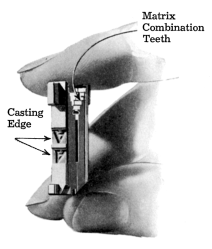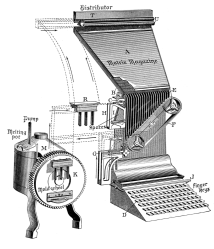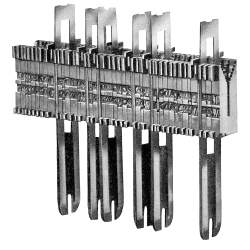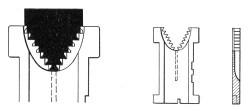If you want to print, say, a book, you probably will type it into a word processor. Someone else will take your file and produce pages on a printer. Your words will directly turn on a laser beam or something to directly put words on paper. But for a long time, printing meant creating some physical representation of what you wanted to print that could stamp an imprint on a piece of paper.
The process of carving something out of wood or some other material to stamp out printing is very old. But the revolution was when the Chinese and, later, Europeans, realized it would be more flexible to make symbols that you could assemble texts from. Moveable type. The ability to mass-produce books and other written material had a huge influence on society.
But there is one problem. A book might have hundreds of pages, and each page has hundreds of letters. Someone has to find the right letters, put them together in the right order, and bind them together in a printing press’ chase so it can produce the page in question. Then you have to take it apart again to make more pages. Well, if you have enough type, you might not have to take it apart right away, but eventually you will.
Automation

That’s how it went, though, until around 1884. That’s when Ottmar Mergenthaler, a clockmaker from Germany who lived in the United States, had an idea. He had been asked for a quicker method of publishing legal briefs. He imagined a machine that would assemble molds for type instead of the actual type. Then the machine would cast molten metal to make a line of type ready to get locked into a printing press.
He called the molds matrices and built a promising prototype. He formed a company, and in 1886, the New York Tribune got the first commercial Linotype machine.
These machines would be in heavy use all through the early 20th century, although sometime in the 1970s, other methods started to displace them. Even so, there are still a few printing operations that use linotypes as late as 2022, as you can see in the video below. We don’t know for sure if The Crescent is still using the old machine, but we’d bet they are.
Of course, there were imitators and the inevitable patent wars. There was the Typograph, which was an early entry into the field. The Intertype company produced machines in 1914. But just like Xerox became a common word for photocopy, machines like this were nearly always called Linotypes and, truth be told, were statistically likely to have been made by Mergenthaler’s company.
Kind of Steampunk

For a machine that appeared in the 1800s, the Linotype looks both modern and steampunk. It had a 90-key keyboard, for one thing. Some even had paper tape readers so type could be “set” somewhere and sent to the press room via teletype.
The machine had a store of matrices in a magazine. Of course, you needed lots of common characters and perhaps fewer of the uncommon ones. Each matrix had a particular font and size, although for smaller fonts, the matrix could hold two characters that the operator could select from. One magazine would have one font at a particular size.
Unlike type, a Linotype matrix isn’t a mirror image, and it is set into the metal instead of rising out of it. That makes sense. It is a mold for the eventual type that will be raised and mirrored. The machine had 90 keys. Want to guess how many channels a magazine had? Yep. It was 90, although larger fonts might use fewer.
Different later models had extra capabilities. For example, some machines could hold four magazines in a stack so you could set multiple fonts or sizes at one time, with some limitations, depending on the machine. Spaces weren’t in the magazine. They were in a special spaceband box.
Each press of a key would drop a matrix from the magazine into the assembler at the bottom of the machine in a position for the primary or auxiliary letter. This was all a mechanical process, and a skilled operator could do about 30 words per minute, so the machines had to be cleaned and lubricated. There was also a special pi channel where you could put strange matrices you didn’t use very often.
Typecasting
When the line was done, you pressed the casting level, which would push the matrices out of the assembler and into a delivery channel. Then it moved into the casting section, which took about nine seconds. A motor moved the matrices to the right place, and a gas burner or electric heater kept a pot of metal (usually a lead/antimony/tin mix that is traditional for type) molten.
A properly made slug from a Linotype was good for 300,000 imprints. However, it did require periodic removal of the dross from the top of the hot metal. Of course, if you didn’t need it anymore, you just dropped it back in the pot.
Justification

You might wonder how type would be justified. The trick is in the space bands. They were larger than the other matrices and made so that the further they were pushed into the block, the more space they took. A mechanism pushed them up until the line of type exactly fit between the margins.
You can see why the space bands were in a special box. They are much longer than the typical type matrices.
How else could you even out the spaces with circa-1900 technology? Pretty clever.

If you have been paying attention, there’s one major drawback to this system. How do the matrix elements get back to the right place in the magazine? If you can’t automate that, you still have a lot of manual labor to do. This was the job of the distributor. First, the space bands were sorted out. Each matrix has teeth at the top that allow it to hang on a toothed distributor bar. Each letter has its own pattern of teeth that form a 7-bit code.
As the distributor bar carries them across the magazine channels, it will release those that have a particular set of teeth missing, because it also has some teeth missing. A diagram from a Linotype book makes it easier to understand than reading about it.
The Goldbergs
You have to wonder if Ottmar was related to Rube Goldberg. We don’t think we’d be audacious enough to propose a mechanical machine to do all this on top of an automated way to handle molten lead. But we admire anyone who does. Thomas Edison called the machine the eighth wonder of the world, and we don’t disagree. It revolutionized printing even though, now, it is just a historical footnote.
Can’t get enough info on the Linotype? There is a documentary that runs well over an hour, which you can watch below. If you’ve only got five minutes, try the short demo video at the very bottom.
Moveable type was to printing what 3D printing is to plastic manufacturing. Which might explain this project. Or this one, for that matter.
















“He had been asked for a quicker method of publishing legal briefs.”
And things have been downhill ever since.
Legal briefs, you say? As Dorothy Parker taught us: “Brevity is the soul of lingerie.”
The competition for type-setting was intense. A Linotype competitor was only one of the really bad investments that Samuel Clemens made.
As a kid we toured his house (mid-1970’s), and they had a machine on display. It was cool, and they mentioned it was a failure. The only other things I recall as a small room for a telephone (like a phone booth built into a wall) and his pool table.
Note that before Linotype machines, there was the Ludlow process, which used hand set matrices to cast a slug for a line of type. This was basically the traditional movable type process, except that since the letters in the matrices were not reversed it was a bit easier to check for errors, and you were guaranteed fresh type for every printing run as old slugs were melted down and new slugs cast.
Ludlow actually survived the introduction of Linotype, being used for larger type sizes that could not be conveniently handled by the machine.
(My father was in advertising, so I got to see these machines in operation at a fairly early age. I still have a Ludlow slug with my name cast into it, but don’t ask me where.)
(Actually, the one piece of printing equipment that I would really like to have in my home was the slide rule they used for computing magnification and focus for photo – offset plates. Two feet long, desk-mounted, with magnifying lens and vernier controls and (IIRC) electric heating to avoid error due to expansion and contraction with temperature, all in an attempt to squeeze an additional place of accuracy out of the calculation.)
It seems to me that these days one could produce small-run press plates with a 3D printer.
I know several artists who do just that. There is a process similar to the old DIY pcb process that removes everything from a printing plate but the inverse type faces. They then use those plates for platen printing.
I think there’s a word missing here:
…until the line of type fit between the margins?
Btw, I wonder what happened when you needed even more space than the space bands provided?
A fascinating look at the last days of the Linotype at the New York times. Look up “Farewell Etaoin Shrdlu (1980)” on the you tubes (I don’t know if i can post links)
This is a misrepresentation of history. Yes, movable types were invented in China by Bi Sheng around 1040 (https://en.wikipedia.org/wiki/Movable_type). But their use was rather limited. The oldest book printed with movable types is only from 1377, over 300 years after the invention. So, no revolution. Books continued to be printed with the block-cutting technique for the next 900 years in China, until the late 19th century. Gutenbergs invention, by contrast, though being 400 years delayed compared to China, only took decades to spread across Europe. In fact, it took over so fast, we have a specific term for ‘books printed with movable type until 1500’: incunable (https://en.wikipedia.org/wiki/Incunable). It is estimated that around 500,000 exemplars from those early days of printing survive, and this is from before printing really took off in the 1500s.
Printing with movable type in China really didn’t work very well because of the number of character required. Instead of sorting through 100 or so, you might have tens of thousands; instead of alphabetical order, they had to be sorted by their rhymes and perhaps by the number of strokes they contained. Movable type really only works well with an alphabet.
This is pretty much the standard narrative, and to anyone who has seen a traditional Chinese or Japanese printing shop with their long rows of shelves necessary to keep sufficient numbers of thousands of characters this sounds very true. OTOH printing with movable wooden types in China has 2010 been awarded a UNESCO world cultural heritage title (http://www.china.org.cn/arts/2023-10/30/content_116231396.htm). There are apparently still a few families in Zhejiang keeping the tradition of printed Clan histories alive, so one has to wonder how practical it really is.
(Note: not linking the Wikipedia page on the history of printing in East Asia because it just repeats the story without giving sources)
Always amazes me how sophisticated typesetting was in, for example, the 1940s.
Lately when i’m reading a book and i notice a typesetting defect, i like to imagine the process that must have produced that result. Like, if for two lines of one page every ‘e’ is half a milimeter lower than the rest of the text…clearly that’s not the result of computer ‘desktop publishing’. But now that i’m sensitive to it, i occasionally notice that the absolute most unpleasant typesetting i ever notice is actually from the dawn of computerized desktop publishing. People were publishing mass-market paperbacks based on low-DPI renders from consumer-grade desktop publishing software, and once you see it it is really jarring. The whole book will look like it was printed on a 1999 inkjet. Absolute lowest point in publishing since the 1800s.
Glad that’s behind us!